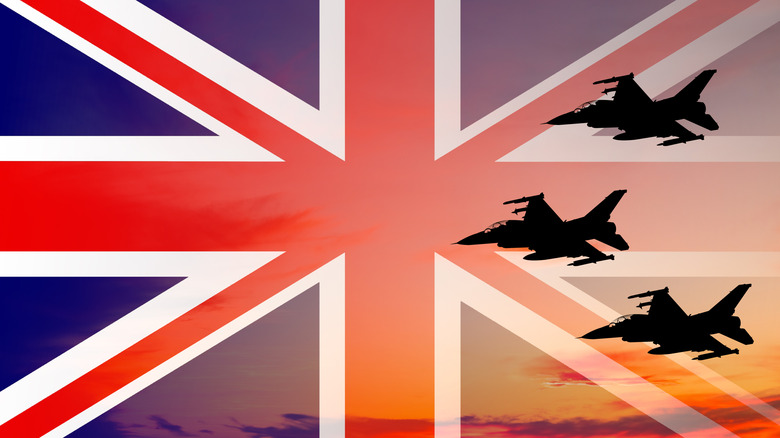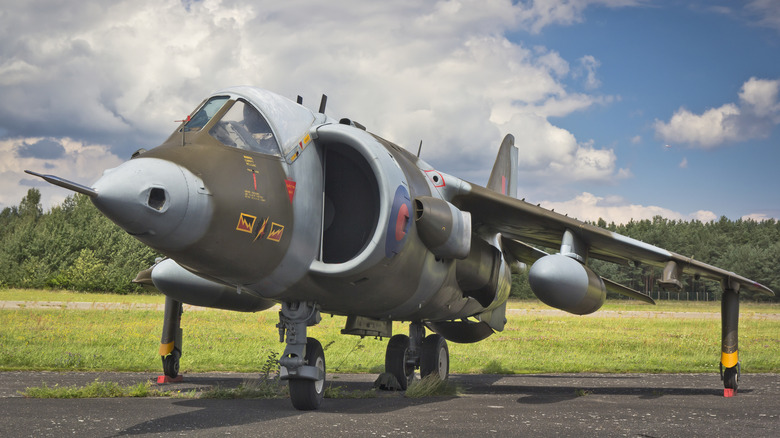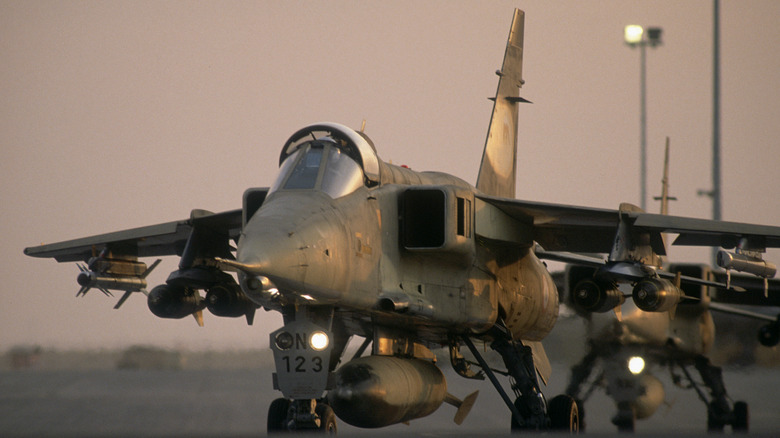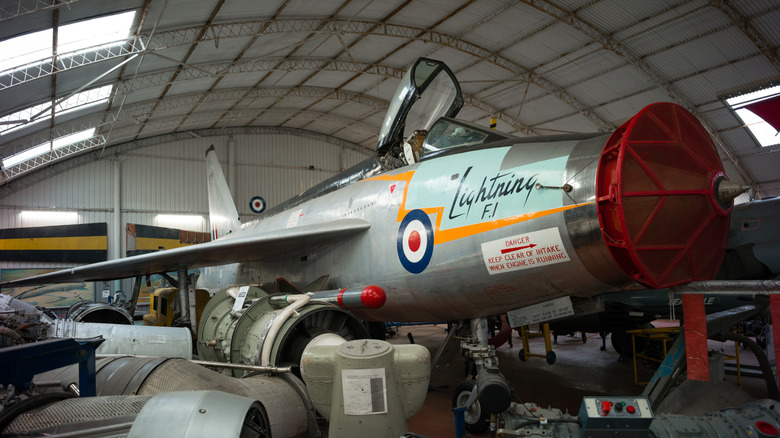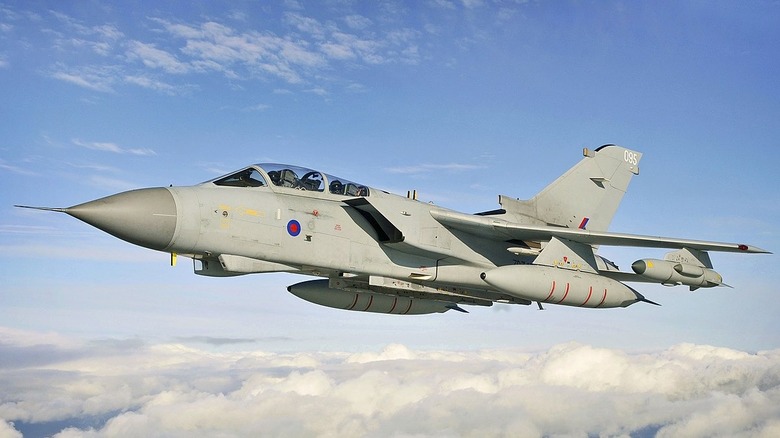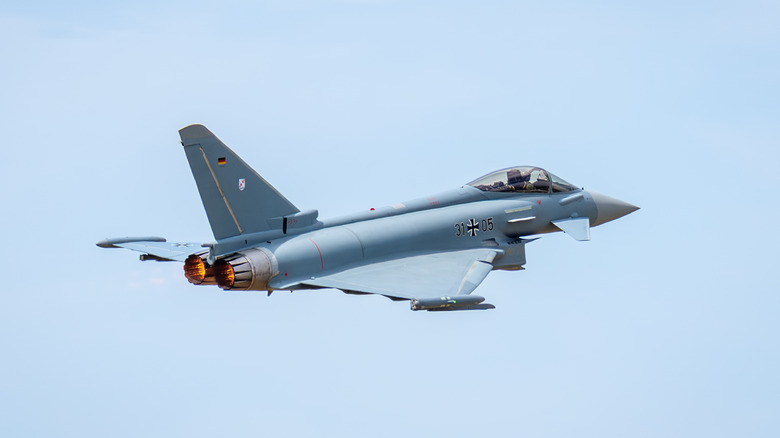5 Of The Newest British-Made Jet Fighters, Ranked By Top Speed
The story of the jet in British military aviation is often overshadowed. England deployed the Allied powers' first and only jet fighter during World War II. The Gloster Meteor made its operational debut in July 1944 — the same month the Luftwaffe's Me 262 Schwalbe, or "Swallow," became the first combat jet fighter in history. The British have been left behind in the telling of the early history of the jet age ever since.
Though Germany often receives credit as the birthplace of jet engine technology, England's aviation industry has a long and proud history dating to when pioneer Sir Frank Whittle obtained patents for a jet-turbo engine in 1930 and was making ground tests by 1937.
The war ended before the Meteor entered aerial combat. Yet there was another battle coming. The Cold War era saw England marching in lockstep alongside the United States. As nations armed for the ideological struggle, some of the best fighter jets of all time were yet to come. While some aircraft on this list do not present as British, they were developed in conjunction with other nations, with England as a primary contributor and operator. These are five of the newest British-made jet fighters ranked by top speed.
Hawker Siddeley Harrier -- 650 to 750 mph
Developed by British firm Hawker Siddeley during the 1960s, the Harrier jump jet became an iconic ground attack plane. The Royal Air Force had been experimenting with vertical takeoff and landing (VTOL) technology, and the Harrier was the first aircraft equipped with it to enter operation in April 1969.
Sleek yet bulbous, the Harrier's pugnacious profile belied its ability to take off and land vertically like a helicopter while performing like a fixed-wing aircraft in flight. The most prominent deployment of the Harrier occurred during the Falklands War of 1982. Its success inspired many later aircraft to employ advanced versions of the VTOL system, including the sixth-generation F-35 Lightning II.
The Harrier was undoubtedly capable of something conventional jets could not do, yet dedicated air superiority fighters far outstripped the Harrier in speed. While other British jets, as we shall see, achieved incredible speeds, a Hawker Siddeley Harrier GR.3 topped out around 750 mph. Other sources pin the number between 650 and 700 mph. That's downright slow compared to others on this list.
The U.S. Marine Corps took delivery of its final AV-8 Harrier, which descended from Hawker Siddeley's original, in 2001. The Harrier's extraordinary career is due in part to its VTOL capabilities, which combine the takeoff and landing benefits of helicopters with fixed-wing jet speed.
Sepecat Jaguar -- 1,000 mph
Geopolitical interests and common goals spurred the British Aircraft Corporation to join forces with the French-owned Breguet Company to develop a light and speedy jet. England hoped to use it as a trainer, while the French wanted a trainer that could deploy as a light attack craft. The project's final product would be much more.
The project began in 1965, and by 1968, the SEPECAT Jaguar was in production. If that doesn't sound British, it's because the joint effort fell under the Société Européenne de Production de l'Avion ECAT (Ecole de Combat et Appui Tactique) — shortened to SEPECAT.
Not as famous as the Harrier or Typhoon, the Jaguar nonetheless went on a 13-year production run. It was deployed with the French and British Air Forces during the Gulf War. If that sounds like a healthy resume for a trainer, it's because the Jaguar ended up as a nuclear-capable low-altitude strike fighter. Don't worry – a two-seater version served as a trainer.
The original Jaguar started a family of 19 additional variants that would ultimately fly in the air forces of Nigeria, Oman, Ecuador, India, the United Kingdom, and France. They were capable supersonic trainers, and many pilots cut their teeth on Jaguars before deploying in them. On a good day, a Jaguar could use its pair of Rolls-Royce/Turbomeca engines to make over 16,000 pounds of thrust, propelling the Jaguar to the neighborhood of 1,000 mph.
The English and French air forces decommissioned the final Jaguars in 2007, but they continue to fly with other nations. India reportedly operates a fleet of more than 100.
English Electric Lightning -- 1,300 mph
Stepping back in time from the Harrier and Jaguar, we find the only all-British supersonic jet ever built. The English Electric Lightning was a direct contemporary of the MiG-21 Fishbed, both second-generation rocketship-cum-fighters born of lessons learned in MiG Alley during the Korean War.
The Electric Lightning P.1A made its maiden flight on August 4, 1954. It was on a mission to blast to high altitudes in short periods. Within three years, the jet was reliably achieving 1,000-plus mph in testing. It was officially deployed with the Royal Air Force in 1959. Powered by a pair of Rolls-Royce Avon 301R turbojet engines in an unusual, vertically staggered configuration, the Electric Lightning made over 25,000 pounds of thrust. Engines stacked upon one another reduced drag, allowing the Lightning to turn every pound of thrust into more speed. It could achieve a climb rate of up to 50,000 feet per minute, meaning it could make its ideal max altitude of 60,000 feet shortly after takeoff.
The English Electric Lightning may be a relic, but it was a Mach 2.0 aircraft flying less than a decade after Chuck Yeager broke the sound barrier. With a 1,300 mph top speed, it was a space-age jet of the Cold War era, and the last all-British supersonic fighter ever.
Panavia Tornado -- 1,400 mph
The Lightning may have been the last all-English project, but other collaborations similar to the one that produced the Jaguar kept the nation flying. The Panavia Tornado was born of a three-way partnership with the United Kingdom, Italy, and West Germany, with development beginning in 1968.
Germany established Panavia to act as a company for the tripartite effort, and the prototype made its maiden flight on August 14, 1974. With two Turbo Union RB199-103 engines making 15,800 pounds of thrust, the Tornado could hit speeds upwards of 1,400 miles per hour at 36,000 feet, thanks in part to variable-sweep wing design.
The pilot sat up front with a navigator directly behind the pilot's seat. The Tornado carried two 27 mm cannons and a pair of AIM-9 Sidewinder air-to-air missiles for self-defense. It could also carry up to 18,000 pounds of various ordnance.
The Tornado entered service with the Royal Air Force on June 5, 1979, and shipped to Germany the following day. Italy received its airframes on September 25, 1981. The U.K. retired the last of its Tornados in 2019, but Germany and Italy keep the jets in limited service. Saudi Arabia has also obtained and operates several Tornados.
Eurofighter Typhoon -- 1,550 mph
The most advanced European jet in operation, the Eurofighter Typhoon is a fourth-generation fighter created by Italy, Germany, Spain, and the United Kingdom. Similar to the multi-national project that brought the Jaguar together, the Typhoon was a collaboration by Western European states to develop an air superiority fighter.
The Typhoon debuted in 1994. While outdated by the most recent generations of fighters, it remains a formidable and versatile airframe for a few reasons. To begin with, the Typhoon is fast. Two Rolls-Royce EJ200 engines are at the heart of the matter. The British contribution to the project powers the Typhoon up to speeds of Mach 2.0 at high altitude, or as fast as 1,550 mph. Considered a swing-role aircraft, the Typhoon is a fast air superiority and ground attack fighter that can dominate an airspace. Ultra maneuverable, it serves with five nations outside of the original partnership: Saudi Arabia, Oman, Kuwait, Qatar, and Austria operate Typhoons.
The Typhoon is being slowly but surely outpaced by next-gen technology. While speedy and formidable, it lacks up-to-date stealth technology used by modern fighter aircraft. Still, in a world of constant security concerns, the Typhoon will have a place for years to come.
